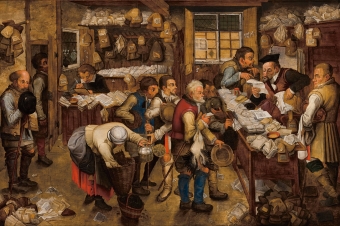Summary:
At this step, students become aware of the case with which will work through documents, in-person or telephone interviews with customers, exchange of electronic messages, narrative of facts by third parties, among other ways. The skills developed at this time involve effective customer communication, listening skills, collect new information, etc.
Objective:
GENERAL GOALS: provide students with the opportunity to reflect about the fundamental institutions of tax law, in particular taxes, applying them to a hypothetical case;
SPECIFIC GOALS: lead students to relate to a hypothetical client, as if they were acting in the law, and know how to select and organize key information about the case;
- It is pretended that students develop:
1) important skills in customer relations, as the polite approach;
2) perception of skill and questioning the most important points of the case;
3) knowledge of the fundamental institutions of tax law and its characteristics (prescription, decadence, etc. responsibility) as well as on the main taxes and their characteristics.
Dynamics:
- REQUIREMENTS: there was no obligatory prior reading. The students did a general search of books in the library and which identified the main issues addressed by the current tax law. The reading (dynamics) occurred in the classroom;
- INTRODUCTION TO THE DYNAMICS: In the first part of the class (or, depending on the course, the entire first class - if the professor wants more preparation), students had all the literature that they raised. The professor selected some of these materials and returned so that students could remember issues they wished, involving fundamental institutions of tax law (prescription, decadence, immunities, etc.) as the main Brazilian taxes (IPI, ISS, etc.). The students worked with the professor to answer questions and remember points of matter. They could even make files in the form of indexes. This reading served as preparation for the meeting with the client, but does not forward any relevant information about the client or the case, for example, what the taxes would be important. The professor indicated points for students to study and instructed students on how to ask the right questions;
- DEVELOPMENT OF THE DYNAMICS: In the second part of the class (or the entire second class, depending on the course), there was the meeting with the hypothetical client, who introduced himself to the students and told their situation. The professor previously delivered a script to the hypothetical client counting relevant information of the case (turnover, number of employees registered and unregistered, etc.), but often the employee is forced to improvise or postpone answers, depending on the questions that are made to them. The students were free to ask any questions about the case, the way they want, including being able to stop the client, simulating an office meeting. The professor did not intervene and just watched;
- END OF THE DYNAMICS: The professor commented the questions asked generally and commented on how the approach or the questions could be better.
- ATTENTION IN THE CLASSROOM:
1) it is recommended that the developer chose to play the role of client, usually a lawyer, should be able to pass the problem to the students as a layman would, that is, telling the facts disorderly, omitting important details and highlighting less relevant information;
2) students have had tax law before, so they already have a theoretical basis.
Evaluation:
- FEEDBACK: There was a collective evaluation at the end of class. Comments on student participation were given individually by e-mail at the time of communication of the note of the activity. Generally, the student who received comments when took a lower grade;
- GRADE EVALUATION: the professor gave a rating score from 0 to 10. Reviewed if students asked the questions expected to obtain the relevant information and if they behaved properly at the meeting with the client. The evaluation was individual and was one of the final four grades of the student.
Time of application:
From 1 to 2 classes (4 hours/class each)
Summary:
It covers the research and collection of customer information, the identification of the relevant issues, the creation of solution strategies and planning work.
Objective:
- GENERAL GOALS: provide to students the opportunity to reflect about the fundamental institutions of tax law, in particular taxes, applying them to a hypothetical case;
- SPECIFIC GOALS: lead students to correctly diagnose the relevant aspects of a problem and select the important facts to begin the search of solutions to problems;
- It was intended that students developed the ability to distinguish relevant facts from the irrelevant facts of the case;
Dynamics:
- REQUIREMENTS: the preparation involves a meeting with the client and the bibliography of materials made in Step 1, but this time for further development. The students could send e-mails for the customer to answer questions;
- INTRODUCTION TO THE DYNAMICS: the professor started the discussion about the case conducting a brainstorming with students about what issues and the most relevant aspects of the case, investigating which aspects did not matter, and therefore not considering it;
- DEVELOPMENT OF THE DYNAMICS: the students were encouraged to interpret the narrative of the case and pointing out those facts that were important to the solution of the case (the company regularization). In the end, the students and the professor, set out the main issues of the case and categorized the problems according to the themes of tax law;
- END OF THE DYNAMICS: After fixing the problems, students were divided into pairs so that each search could be in greater depth of these problems.
Evaluation:
- FEEDBACK: student received comments about their participation individually by e-mail at the time of communication of the note of the activity. Generally, the student who received comments were when took a lower grade;
- GRADE EVALUATION: the professor took rating score from 0 to 10. Reviewed students' ability to raise the most important issues for the resolution of the case, the ability to self-organize to search. The evaluation was individual.
Time of application:
2 classes (4 hours / class each)
Summary:
At this step, usually the longer one, there are the research papers, legal analysis and writing. In this step, the students should organize the division of labor, observe schedules and appropriate case.
Objective:
- GENERAL GOAL: provide students with the opportunity to reflect about the fundamental institutions of tax law, in particular taxes, applying them to a hypothetical case;
- SPECIFIC GOAL: lead students to seek solutions that optimize the tax burden and risks, given the client's profile. They can search for alternative solutions (scenario A and scenario B).
- The students are intended to develop:
1) deeper knowledge of tax law;
2) the ability to identify scenarios and offer viable solutions for the customer in the concrete situation, according to the case and the customer profile.
Dynamics:
- REQUIREMENTS: there was no previous reading. Step 2 gives the analysis of this case requirement;
- INTRODUCTION TO THE DYNAMICS: The problems fixed after the discussion were categorized and divided among the students, who were responsible for researching solutions and contact the customer for more information and documents (via email, always with a copy to the professor).
- DEVELOPMENT OF THE DYNAMICS: Basically, the students searched for the solutions in groups at in the classroom, using books, laptops, etc. or in study rooms. The professor tried to intervene, as little as possible, preventing in advance the emergence of unviable or undesirable solutions, but helped the students with their questions.
- END OF THE DYNAMICS: the dynamics ended with the delivery of the results, a memorandum containing solution to the case directly to the customer without review from the Professor.
- ATTENTION IN THE CLASSROOM: on the execution part, the students usually disperse and therefore, it is necessary to control the class. The professor in this case serves to warn students of the importance of the activity. On the other hand, when the search part left as extra-activity, the results founded that some students worked more than others did.
Evaluation:
- FEEDBACK: there were no comments on the part of execution, only on the outcome;
- GRADE EVALUATION: The professor gave a score from 0 to 10 to the memorandum delivered. It was evaluated whether the research was well done, the solution was feasible and appropriate to the case and to the client. The score was to the group.
Time of application:
From 2 to 3 classes (4 hours/class each)
Summary:
It includes the intermediates and the outcome of the clinical work and considers not only the technical quality of the delivered product but also the preparation for presentation to the client, posture, language and techniques used.
Objective:
- GENERAL GOALS: to provide students with the opportunity to reflect about the fundamental institutions of tax law, in particular taxes, applying them to a hypothetical case;
- SPECIFIC GOALS: to lead students to relate to a hypothetical client to present you specific solutions for the specific case.
- It was intended that students developed:
1) posture and dealing with the customer, especially in didacticism to explain the solutions and the language used;
2) the ability to work in groups and integrate with colleagues.
Dynamics:
- REQUIREMENTS: there was no previous reading. A new scheduled client meeting discussed in the memo of the students. The client received the memo in advance so that he could prepare and cause students;
- INTRODUCTION TO THE DYNAMICS: there was a short presentation of the memorandum and solutions by the students to the customer, this time integrated all groups at the same table with the customer. The professor did not involve directly in the activity, remaining outside, just watching;
- DEVELOPMENT OF THE DYNAMICS: the customer did comments on the solutions and questioned students about the proposals. The students were able to improvise and change their own solutions, negotiating with the customer new alternatives;
- END OF THE DYNAMICS: after the meeting simulation with the customer, the person who played this role made their own observations, at this time as a professional, on the solutions proposed by the students. Then the professor, without the customer's presence, gave a collective evaluation performance of the memorandum, and discussed some observations made by the employee himself;
- ATTENTION IN THE CLASSROOM: the employee must be aware of the questions that a nonprofessional would do (overly technical terms, solutions that seem risky, etc.).
Evaluation:
- FEEDBACK: the dynamics talked about the end of the simulated meeting both by the professor and the employee;
- GRADE EVALUATION: The professor gave a score from 0 to 10 for student participation in trading. It was evaluated more strongly the involvement of students in relation to posture and dealing with the customer.
Time of application:
1 class (4 hours/class)




